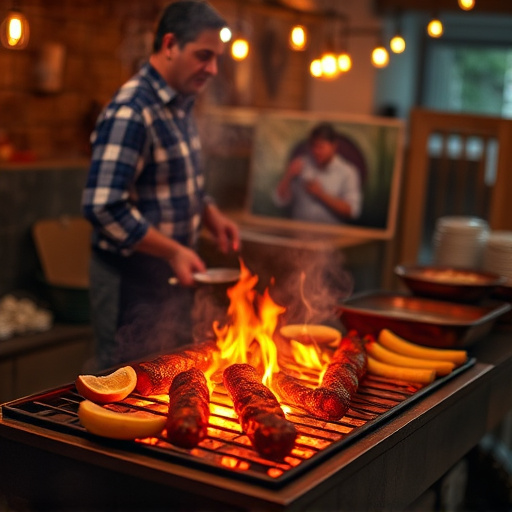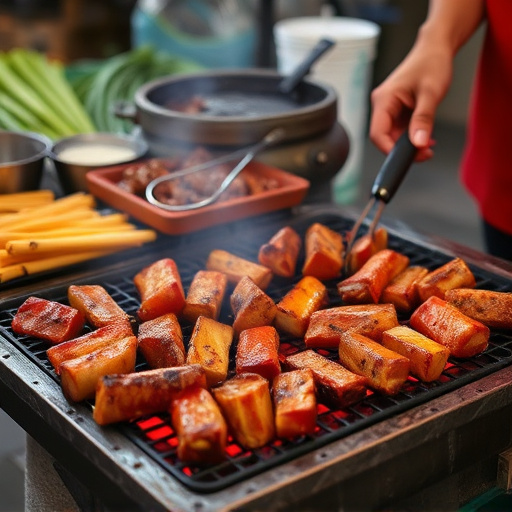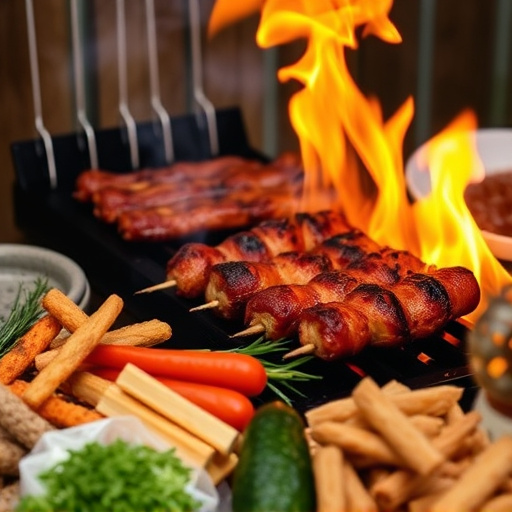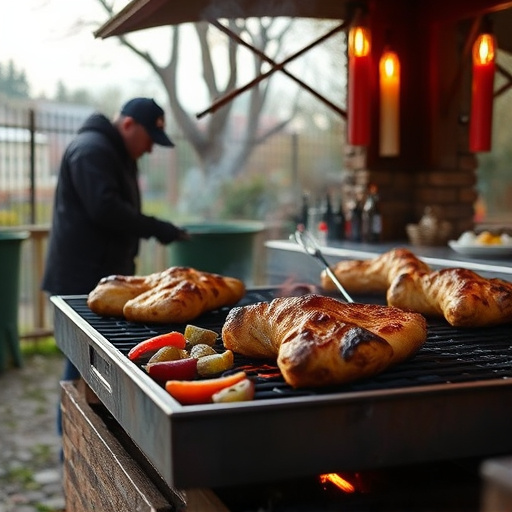Selecting high-quality beef brisket with even marbling and rich color is essential for an exceptional BBQ Beef Brisket Recipe. Dry-aging the meat at cool temperatures enhances flavor, texture, and crust formation. A flavorful rub of salt, pepper, garlic, paprika, and spices prepares the brisket for slow-smoking between 225°F – 250°F for 1-1.5 hours per pound. Crafting a balanced BBQ sauce with tomato base, sweetness, smokiness, tanginess, and personalized touches completes the dish. Glazing techniques add depth of flavor and moisture. Serving with coleslaw, potato salad, cornbread, and sauces elevates the overall dining experience.
“Unleash your inner grill master with the ultimate guide to crafting the perfect BBQ beef brisket recipe. From selecting the ideal cut of meat to mastering the art of smoking, this journey delves into every step of achieving juicy, tender brisket with a rich, mouthwatering barbecue sauce. Discover dry-aging techniques, rub recipes, and precise smoking window strategies for a truly exceptional culinary experience. Get ready to impress your taste buds with these expert tips and elevate your BBQ game.”
- Choosing the Right Beef Brisket for Your BBQ Recipe
- The Art of Dry-Aging: Enhancing Brisket Flavor
- Spicing It Up: Rubbing Techniques for Maximum Flavor
- Smoking 101: Finding the Perfect Temperature and Time
- Creating a Classic BBQ Sauce: Ingredients and Variations
- Glazing Techniques: Adding the Final Touch to Your Brisket
- Serving Suggestions: Pairings and Side Dishes
Choosing the Right Beef Brisket for Your BBQ Recipe

When it comes to a juicy, mouthwatering BBQ Beef Brisket Recipe, selecting the perfect cut is half the battle won. Look for a high-quality brisket with even marbling; this fat distribution ensures a tender, flavorful result. Aim for a good balance between lean and fatty sections—too much fat can make it tough, while too little will lead to dryness. The ideal brisket should have a rich, deep color, indicating well-marbled meat.
Consider the point cut for a popular choice; this cut offers a mix of flavor and tenderness, making it suitable for slow-cooking methods used in BBQ recipes. Remember, the quality of your ingredients sets the stage for a delicious dish, so take your time to find a brisket that meets these criteria, and you’ll be well on your way to crafting an exceptional BBQ Beef Brisket Recipe.
The Art of Dry-Aging: Enhancing Brisket Flavor

The art of dry-aging is a crucial step in crafting the perfect BBQ beef brisket recipe. This time-honored technique involves removing the brisket from its packaging and allowing it to breathe for several weeks, during which natural enzymes break down proteins, resulting in tender, flavorful meat. The process begins by storing the brisket at a specific temperature range—typically between 35°F and 40°F (1.7°C to 4.4°C)—in a well-ventilated area. Over time, the exterior of the meat develops a desirable rust-like color as moisture evaporates, enhancing its complexity.
Dry-aging not only improves texture but also intensifies the brisket’s natural flavors. The outer layers, once tough and fibrous, transform into delectable crusts that lock in juicy goodness. This process is particularly beneficial for BBQ beef brisket recipes, as it allows the rich barbecue sauce to cling to every tender slice, creating a harmonious blend of smoky sweetness and savory depth.
Spicing It Up: Rubbing Techniques for Maximum Flavor

When it comes to a mouthwatering BBQ Beef Brisket Recipe, the key lies in the rub. Spicing up your brisket before cooking adds depth and complexity to its flavor profile. A good rub should combine salt, pepper, garlic, paprika, and other aromatic spices like onions or cayenne pepper for heat. These ingredients not only enhance the meat’s taste but also help to break down tough connective tissues during slow-cooking.
The act of rubbing the spice mixture over the brisket serves multiple purposes. It helps to draw out moisture, creating a juicier final product. The spices also create a delicious crust on the exterior, adding texture and flavor as the meat cooks. For maximum impact, pat the rubbed brisket dry before cooking; this step ensures the spices stick to the meat and intensify during the slow-cook process.
Smoking 101: Finding the Perfect Temperature and Time

Smoking 101: Mastering the Art
The beauty of smoking beef brisket lies in its patience and precision. The perfect BBQ Beef Brisket Recipe demands a delicate balance between time and temperature. Aim for an ideal cooking range of 225°F to 250°F (107°C to 121°C) to ensure slow, even cooking. This method allows the brisket to render its rich fats, making it tender and juicy. Time is a crucial factor; brisket typically takes around 1 to 1.5 hours per pound to smoke, so plan accordingly for a mouthwatering result.
Remember, low and slow is the mantra for achieving that coveted, fall-off-the-bone texture. By maintaining a consistent temperature, you can transform tough cuts like brisket into a delectable culinary delight. Whether you’re a seasoned smoker or just starting, understanding these fundamentals will elevate your BBQ Beef Brisket Recipe to new heights.
Creating a Classic BBQ Sauce: Ingredients and Variations

Creating a classic barbecue sauce is an art that every serious BBQ enthusiast should master, especially when preparing a mouthwatering BBQ beef brisket recipe. The key to a great sauce lies in balancing sweet, smoky, and tangy flavors. Traditionally, tomato-based sauces are favored for their ability to enhance the natural juices of the brisket. Start with a base of tomato paste or crushed tomatoes, then add brown sugar for a rich sweetness, vinegar (such as apple cider or white) for tanginess, and a touch of Worcestershire sauce for depth of flavor. Smoked paprika and black pepper bring a subtle smokiness, while garlic and onion powders add a savory kick. Adjust the seasoning to suit your taste preferences.
Variations on this classic can include substituting honey or maple syrup for sugar, using different types of vinegar like balsamic or white wine vinegar, or adding unique ingredients like chili powder, cayenne pepper, or even a splash of whiskey or bourbon for a more complex flavor profile. Experimentation is encouraged; after all, the best BBQ sauce is one that reflects your personal taste.
Glazing Techniques: Adding the Final Touch to Your Brisket

Glazing techniques are an art that can elevate your BBQ beef brisket recipe to new heights. After slow-roasting the brisket until it’s tender and juicy, the glaze acts as the final touch, adding a burst of flavor and a shiny, appealing crust. Common methods include brush-on glazes, where you evenly coat the meat during the last 15-20 minutes of cooking, allowing the sauce to caramelize and stick to the brisket. Alternatively, for a more intense flavor, you can baste your brisket with the glaze during the entire cooking process, ensuring it stays moist while adding depth of taste.
Experimenting with different ingredients in your glaze is key; a blend of barbecue sauce, vinegar, brown sugar, and spices creates a rich profile that clings to the meat. Some chefs even use fruit purees or juices for a unique twist, offering a sweet and tangy contrast to the smoky brisket. Mastering these glazing techniques will not only make your BBQ beef brisket recipe stand out but also ensure every bite is an indulgent experience.
Serving Suggestions: Pairings and Side Dishes

For a truly satisfying meal, consider serving your juicy BBQ beef brisket with a range of complementary sides. Classic pairings include coleslaw and potato salad, which offer a refreshing crunch to balance the rich, smoky flavor of the brisket. Cornbread is another excellent option, adding a touch of sweetness and texture. If you’re looking for something more substantial, baked beans and garlic mashed potatoes are perfect companions, creating a hearty and comforting dish.
Don’t forget about the sauce! Drizzle your favorite BBQ sauce over the brisket or serve it on the side for guests to customize their plates. The rich, tangy flavor of a good BBQ sauce can elevate the entire dining experience. Pair with a refreshing cold beer or a crisp glass of vinegar-based white wine to complement the robust flavors of the beef brisket and sauce in your BBQ Beef Brisket Recipe.
